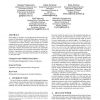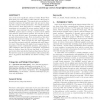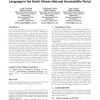WIDM
2009
ACM
14 years 6 months ago
2009
ACM
In this paper we introduce a novel approach for the thematic organization of bibliographic records that builds upon a semantic relatedness measure we have implemented for this tas...
W4A
2009
ACM
14 years 6 months ago
2009
ACM
: This article relates a reflexion on the experience of authors as teachers in the E-learning modality of university-level teaching. Presently we live in the peak of the new techno...
W4A
2009
ACM
14 years 6 months ago
2009
ACM
This paper first presents a framework for filtering the Web Accessibility Guidelines according to contexts of use. It then presents a prototype that implements the framework and e...
W4A
2009
ACM
14 years 6 months ago
2009
ACM
The popularity of social media is affecting society as they are changing the way communication, collaboration, interaction, and information are produced and consumed. A part of t...
W4A
2009
ACM
14 years 6 months ago
2009
ACM
One of the most significant advances behind World Wide Web (Web) 2.0 is the ability to allow parts of a Web page to be updated independently. This can provide an exciting, intera...
W4A
2009
ACM
14 years 6 months ago
2009
ACM
Persons with disabilities are often marginalised from economy and society due to the lack of access to disability related information and services. Through the use of assistive te...
VRML
2009
ACM
14 years 6 months ago
2009
ACM
The documentation and presentation of 3D digital content is a critical but non-trivial task for the Cultural Heritage sector. Curators are often faced with the task of cataloguing...
VRML
2009
ACM
14 years 6 months ago
2009
ACM
VRML
2009
ACM
14 years 6 months ago
2009
ACM
We present a model that allows to directly integrate X3D nodes into HTML5 DOM content. This model tries to fulfill the promise of the HTML5 specification, which references X3D f...
VRML
2009
ACM
14 years 6 months ago
2009
ACM
In this article we present a novel approach, the 2-Layer Interface Paradigm (2LIP), for designing simple yet interactive 3D web applications, an attempt to marry advantages of 3D ...



